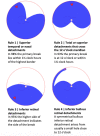Rhegmatogenous retinal detachment: a review of current practice in diagnosis and management
- PMID: 33083551
- PMCID: PMC7549457
- DOI: 10.1136/bmjophth-2020-000474
Rhegmatogenous retinal detachment: a review of current practice in diagnosis and management
Erratum in
-
Correction: Rhegmatogenous retinal detachment: a review of current practice in diagnosis and management.BMJ Open Ophthalmol. 2021 Mar 14;6(1):e000474corr1. doi: 10.1136/bmjophth-2020-000474corr1. eCollection 2021. BMJ Open Ophthalmol. 2021. PMID: 33817341 Free PMC article.
Abstract
Rhegmatogenous retinal detachment (RRD) is a common condition with an increasing incidence, related to the ageing demographics of many populations and the rising global prevalence of myopia, both well known risk factors. Previously untreatable, RRD now achieves primary surgical success rates of over 80%-90% with complex cases also amenable to treatment. The optimal management for RRD attracts much debate with the main options of pneumatic retinopexy, scleral buckling and vitrectomy all having their proponents based on surgeon experience and preference, case mix and equipment availability. The aim of this review is to provide an overview for the non-retina specialist that will aid and inform their understanding and discussions with patients. We review the incidence and pathogenesis of RRD, present a systematic approach to diagnosis and treatment with special consideration to managing the fellow eye and summarise surgical success and visual recovery following different surgical options.
Keywords: retina; treatment surgery; vitreous.
© Author(s) (or their employer(s)) 2020. Re-use permitted under CC BY-NC. No commercial re-use. See rights and permissions. Published by BMJ.
Conflict of interest statement
Competing interests: None declared.
Figures





Similar articles
-
Rhegmatogenous retinal detachment surgery: A review.Clin Exp Ophthalmol. 2023 Apr;51(3):271-279. doi: 10.1111/ceo.14205. Epub 2023 Jan 25. Clin Exp Ophthalmol. 2023. PMID: 36640144 Review.
-
Pars plana vitrectomy versus scleral buckling for repairing simple rhegmatogenous retinal detachments.Cochrane Database Syst Rev. 2019 Mar 8;3(3):CD009562. doi: 10.1002/14651858.CD009562.pub2. Cochrane Database Syst Rev. 2019. PMID: 30848830 Free PMC article.
-
Changing trends in surgery for retinal detachment in Korea.Korean J Ophthalmol. 2014 Dec;28(6):451-9. doi: 10.3341/kjo.2014.28.6.451. Epub 2014 Nov 19. Korean J Ophthalmol. 2014. PMID: 25435747 Free PMC article.
-
Historical, Current and Future Approaches to Surgery for Rhegmatogenous Retinal Detachment.Tohoku J Exp Med. 2019 Jul;248(3):159-168. doi: 10.1620/tjem.248.159. Tohoku J Exp Med. 2019. PMID: 31308289 Review.
-
Pneumatic retinopexy combined with scleral buckling in the management of relatively complicated cases of rhegmatogenous retinal detachment: A multicenter, retrospective, observational consecutive case series.J Int Med Res. 2018 Jan;46(1):316-325. doi: 10.1177/0300060517724931. Epub 2017 Aug 25. J Int Med Res. 2018. PMID: 28840752 Free PMC article.
Cited by
-
Climate and Rhegmatogenous Retinal Detachment: A Comprehensive Review and Future Research Guidelines.Clin Ophthalmol. 2024 Oct 29;18:3083-3095. doi: 10.2147/OPTH.S476142. eCollection 2024. Clin Ophthalmol. 2024. PMID: 39493840 Free PMC article. Review.
-
Macular vascularisation changes analysed using OCT angiography after successful rhegmatogenous retinal detachment repair.Int J Ophthalmol. 2023 Jan 18;16(1):81-87. doi: 10.18240/ijo.2023.01.12. eCollection 2023. Int J Ophthalmol. 2023. PMID: 36659952 Free PMC article.
-
Autofluorescence Imaging in the Long-Term Follow-Up of Scleral Buckling Surgery for Retinal Detachment.J Ophthalmol. 2022 Feb 27;2022:2119439. doi: 10.1155/2022/2119439. eCollection 2022. J Ophthalmol. 2022. PMID: 35265365 Free PMC article.
-
The Impact of Travel Distance to Delayed Presentation and Follow-up Attendance of Retinal Detachment Cases in Surabaya, Indonesia.Juntendo Iji Zasshi. 2022 Feb 4;68(1):36-43. doi: 10.14789/jmj.JMJ21-0024-OA. eCollection 2022. Juntendo Iji Zasshi. 2022. PMID: 38911010 Free PMC article.
-
Two-port dry vitrectomy for rhegmatogenous retinal detachment: a pilot study.Eye (Lond). 2023 Dec;37(18):3801-3806. doi: 10.1038/s41433-023-02617-6. Epub 2023 Jun 10. Eye (Lond). 2023. PMID: 37301938 Free PMC article.
References
-
- Strauss DS, Choudhury T, Baker C, et al. . Visual outcomes after primary repair of chronic versus Super-Chronic Macula-Off rhegmatogenous retinal detachments in an underserved population. Invest Ophthalmol Vis Sci 2011;52:6139.
Publication types
LinkOut - more resources
Full Text Sources
